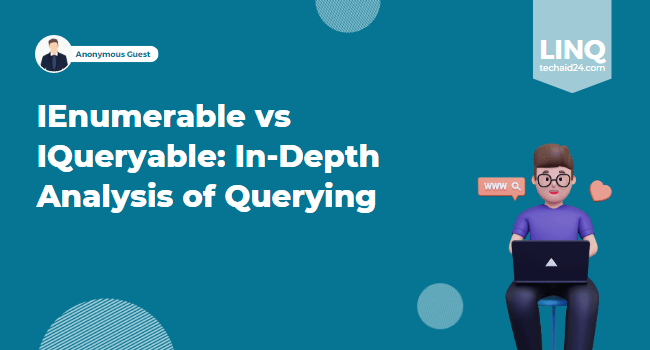When working with data in C#, developers often encounter scenarios where they need to query and manipulate collections. Two commonly used interfaces for querying data are IEnumerable and IQueryable. While they might seem similar at first glance, they have distinct differences that can significantly impact performance and behavior. In this article, we will explore the differences between IEnumerable vs IQueryable, highlighting their appropriate use cases and how they affect querying operations.
IEnumerable: Basic Enumeration
The IEnumerable interface is one of the fundamental interfaces in C# that represents a sequence of objects. It provides a simple way to iterate over a collection of items and is supported by most collections in the .NET framework. Let’s take a look at an example:
|
1 2 3 4 5 6 |
IEnumerable<int> numbers = new List<int> { 1, 2, 3, 4, 5 }; foreach (var number in numbers) { Console.WriteLine(number); } |
In the above example, the IEnumerable interface allows us to iterate over a list of integers and print each number to the console. The key characteristic of IEnumerable is that it represents an in-memory collection, and all the processing of data occurs on the client side.
Here are a few important points about IEnumerable:
- Eager loading: When you work with IEnumerable, data is loaded into memory all at once. This means that when you invoke a query, it retrieves all the data from the data source and performs operations on the entire collection.
- Deferred execution: IEnumerable supports deferred execution, which means the query is not executed immediately. Instead, it is executed only when you iterate over the collection or explicitly trigger the execution using methods like
ToList()orToArray(). This can be advantageous when working with large datasets, as it allows for more efficient memory utilization. - Limited query capabilities: IEnumerable provides basic querying capabilities using extension methods like
Where(),Select(), andOrderBy(). However, these methods operate on the entire collection and cannot be translated into a specific query language for a data source.
IQueryable: Queryable Interface for Data Sources
The IQueryable interface inherits from IEnumerable and extends its querying capabilities by allowing the construction of more complex queries. IQueryable represents a query that can be executed against a specific data source, such as a database, and it enables the generation of efficient queries by translating them into the appropriate query language (e.g., SQL). Let’s see an example:
|
1 2 3 4 5 6 |
IQueryable<Product> query = dbContext.Products.Where(p => p.Price > 50).OrderBy(p => p.Name); foreach (var product in query) { Console.WriteLine(product.Name); } |
In the above example, the IQueryable interface allows us to construct a query that filters products based on a price condition and orders them by name. The query is executed on the database server, minimizing data transfer between the server and the application.
Here are a few important points about IQueryable:
- Query translation: The key advantage of IQueryable is its ability to translate queries into the query language of the underlying data source. This means that the query can be executed directly on the data source, minimizing data transfer between the data source and the application.
- Deferred execution with provider support: Like IEnumerable, IQueryable also supports deferred execution. However, IQueryable incorporates a provider model that allows the underlying data source to handle query execution. For example, when working with a database, the provider can generate efficient SQL queries to retrieve only the required data from the server.
- Enhanced query capabilities: IQueryable provides more advanced querying capabilities compared to IEnumerable. It supports methods such as
Where(),Select(),OrderBy(), and additional operations likeJoin(),GroupBy(), andTake(). These operations can be translated into the appropriate query language, allowing for more precise filtering, sorting, and data retrieval.
Choosing Between IEnumerable vs IQueryable
Choosing the appropriate interface depends on the specific requirements of your application. Here are some guidelines to help you decide:
- Use IEnumerable when:
- Working with in-memory collections or small datasets.
- The query operations are straightforward and do not require complex filtering or ordering.
- The data retrieval and processing can be done efficiently on the client side.
- Use IQueryable when:
- Querying large datasets or accessing remote data sources such as databases.
- Needing advanced query capabilities like filtering, sorting, or joining.
- Optimizing query performance by allowing the data source to handle query execution.
In summary, IEnumerable and IQueryable are two interfaces in C# that serve different purposes when it comes to querying and manipulating data. IEnumerable is suitable.






Leave a Comment